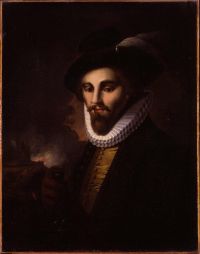Sir Walter Raleigh (Painting)
Artist/Maker: possibly Edward Alcock
Created: 1787
Origin/Purchase: England
Materials: oil on canvas
Dimensions: 64.8 × 50.2 (25 1/2 × 19 3/4 in.)
Location: Parlor
Provenance: Thomas Jefferson; by purchase at the Harding Gallery sale in 1833 to Colonel James W. Sever; by gift to the Pilgrim Society in Plymouth, Massachusetts, in 1868; by purchase to Thomas Jefferson Foundation in 1965
Accession Number: 1965-14
Historical Notes: Although Sir Walter Raleigh was a historian and poet, Jefferson's interest in him stemmed from his early exploration of the North Carolina coast in 1584 and a premature attempt to colonize America. Jefferson owned Raleigh's Judicious and Selected Essayes and Observations (1650) and History of the World (1736). To explain government in Virginia, Jefferson began with Queen Elizabeth's agreement with Raleigh in Notes on the State of Virginia, which was published in English at about the same time that Jefferson acquired the portrait of Raleigh.
In 1786 Jefferson toured English country estates and gardens with John Adams, who was then serving as the American minister to Great Britain. Together they saw a picture of Sir Walter Raleigh at Birmingham. Jefferson then asked either Adams or Colonel Smith to obtain a likeness of Raleigh for him. He wanted "to add it to those of other principal American characters which I have or shall have."[1] In October and December of the same year, Jefferson renewed his request to Smith for both "Mr. Adams's [by Mather Brown] and Sir. Walter Raleigh's pictures."[2] When neither painting had appeared by February 19, Jefferson wrote a third reminder, "—Remember Mr. Adams's picture, I pray you; and Sir Walter Raleigh's too."[3] On May 19, Smith notified Jefferson that the portrait was on its way: "Sir Walter Raleigh I immagine [sic] will be at your House to receive you."[4] Apparently Smith located a copy of a different portrait of Raleigh, probably from a London collection, rather than the one Jefferson had seen at Birmingham. Nearly a year after the painting was shipped to Jefferson in Paris, Smith wrote, "You have never yet informed me whether the picture I send [sent] you was the one you saw at Bermingham or Brumigum, and whether the price I gave, was anything near what you could have obtained it for, previous to its visit to the Capital."[5]
The portrait of Raleigh was exhibited on the top tier of the Parlor next to Cortez and adjacent to other early explorers of America — Columbus, Vespucci, Magellan, and Cortez. In the "Catalogue of Paintings" Jefferson mistakenly wrote "copy from an Original of Holben," but Hans Holbein (1497/8-1543) had predeceased Raleigh by nearly ten years.
The copyist may be Edward Alcock, who was active in Bath in 1757 and living in Birmingham in 1759-60, after an unidentified artist.[6]
- Text from Stein, Worlds, 136
Further Sources
- Thomas Jefferson Foundation. Thomas Jefferson's Libraries Project. The History of the World, in Five Books (1736). More information about Jefferson's copy of Raleigh's book.
- Thomas Jefferson Foundation. Thomas Jefferson's Libraries Project. Judicious and Selected Essays and Observations (1650). More information about Jefferson's copy of Raleigh's book.
References
- ^ Jefferson to William Stephens Smith, October 22, 1786, in PTJ, 10:479. Transcription available at Founders Online.
- ^ Jefferson to Smith, December 20, 1786, in PTJ, 10:620. Transcription available at Founders Online.
- ^ Jefferson to Smith, February 19, 1787, in PTJ, 11:169. Transcription available at Founders Online.
- ^ Smith to Jefferson, May 19, 1787, in PTJ, 11:365. Transcription available at Founders Online.
- ^ Smith to Jefferson, February 22, 1788, in PTJ, 12:620. Transcription available at Founders Online.
- ^ Ellis Waterhouse, The Dictionary of British 18th Century Painters in Oils and Crayons (Woodbridge, England: Antique Collectors' Club, 1981), 23.
